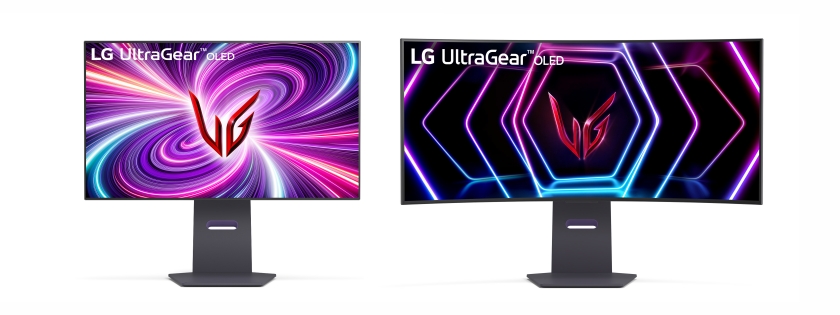LG's new gaming monitor lets you switch monitor refresh rates up to 480 Hz on the fly — Ultragear flips between 1080p at 480 Hz and 4K at 240 Hz with the press of a button
LG revealed two 16:9 flat monitors and four 800R 21:9 WQHD monitors with OLED panels

LG has revealed new monitors for 2024 that will show up at CES 2024 and then show up for purchase shortly after. These include a mix of curved and standard monitor panels, with one going as high as 480 Hz.
A 32-inch non-curved OLED gaming monitor, dubbed the 32GS95UE, features the first-of-its-kind dual-Hz feature that allows the user to swap between two resolutions with its assigned refresh rates. Users with this monitor can swap between 4K resolution using a 240 Hz refresh rate or 1080p resolution running at 480 Hz with a click of a hotkey at the bottom of the monitor.
The monitor has two in-built speakers and a woofer, while the headphone port supports DTS Virtual: X. LG says that its speakers are purposely built behind the panel as a part of its Pixel Sound Technology to get direct sound from the front rather than from the sides of the speaker.
Usually, inbuilt speakers are overlooked by people who opt to use their headphones or speakers. But perhaps good placement will be enough to make some people appreciate the sound from a monitor. We can only wait and see.
Other Monitor Specifications

The 32-inch 4K and the 27-inch 1440p OLED monitors are the only flat 16:9 monitors shown for the 2024 release, while the rest are 21:9 WQHD (3440 X 1440) monitors.
The 27GS95QE is a 16:9 1440p monitor with a 240Hz refresh rate and a 65W USB Type-C port. The rest of the monitors are 21:9 ultrawide 3440 x 1440 800R curved monitors in 39-inch, 34-inch and 45-inch without USB Type-C and speakers (45GS95QE, 39GS95QE and the 34GS95QE). The 45GS95QB is a 44.5-inch 21:9 monitor also supporting 3440 x 1440 resolution with an 800R curved radius and includes USB Type-C 65w with a pair of inbuilt speakers.
LG provides a stand for 16:9 monitors with all the range of movement tilt, height, swivel and 90-degree pivot on both sides. The 21:9 monitors do not have a pivot option. All of these monitors include a 100 mm x 100mm compatible VESA mount.
Get Tom's Hardware's best news and in-depth reviews, straight to your inbox.
All of the monitors LG introduced use anti-glare low-reflection panels with 0.03 ms grey-to-grey response time and feature a nearly bezel-free design on all four sides. It is rated for Vesa DisplayHDR True Black 400 and is compatible with both Nvidia G-Sync and AMD FreeSync Premium Pro. For video output, these monitors include two HDMI 2.1 and 1 DisplayPort 1.4 inputs.
Why offer 1080p resolution on a 32-inch display?
The 32GS95UE monitor — the one that can swap between resolutions and refresh rates — provides a 1080p option, which isn't terribly common on high-end monitors at 32-inches. But some gamers, like those who play compeitive first person shooters or esports, are more likely to turn down their resolution in exchange for higher frame rates. Those players may still want to jump to 4K resolution for non-gaming purposes. LG found a way to provide an option to reduce resolution and increase the refresh rate on a single display.
Out of the two 16:9 monitors LG announced today, the 32-inch is the only one with 4K resolution, not to mention OLED. The one-click option on the hardware certainly sounds easier than changing resolution and frame rate manually in Windows.
I am curious to know if display manufacturers considered making 24-inch OLED monitors with 1080p resolution and high refresh rates for competitive FPS gamers since Zowie and Asus announced a TN model with high refresh rates a few days ago.

Roshan Ashraf Shaikh has been in the Indian PC hardware community since the early 2000s and has been building PCs, contributing to many Indian tech forums, & blogs. He operated Hardware BBQ for 11 years and wrote news for eTeknix & TweakTown before joining Tom's Hardware team. Besides tech, he is interested in fighting games, movies, anime, and mechanical watches.
-
Makaveli 800R curve is too aggressive where is the 1800R option?Reply
Also zero mention of Burn in Warranty and these are OLED panels RED FLAG -
johnsaar2005 "Also zero mention of Burn in Warranty and these are OLED panels RED FLAG"Reply
LG offers 2 year burn in protection on all of their OLED gaming monitors. The offer 5 year burn in protection on their TVs staring with the LG EVO based panels like the LG C2 EVO. Older OLED TVs and monitors like the LG CX and C1 series or older don't have this warranty though. Also with newer OLED TVs and monitors from all the TV manufacturers like Samsung, Sony, and LG have technology built-in to stop burn in. LG has pixel shifter and pixel refresher technology which almost eliminates burn in risk. The key word there though is "almost" if your going to use this monitor for work I wouldn't bother if you're an accountant and you're looking at spreadsheets, documents, or will have static images sitting on the screen for 8 to 12 hours a day. But if you are just gaming, watching videos, working sometimes, and surfing the web I doubt you will ever have to worry or deal with burn in on any newer OLED panel. I use a 48 inch LG C1 OLED as a computer monitor and I work in the IT industry from home. I have not had a single issue with any type of burn in and sometimes I'll game all day on a weekend. I've had the C1 for over a year now I bought it refurbished from Microcenter for under $700 and it's been amazing. I'll never go back to LCD monitors. Burn in was worth the risk to me the moment I played my games on the LG C1 especially Elden Ring in HDR. It even made my old games feel new because they looked so different on the OLED. It was honestly kind of like the first time I installed an SSD in my computer the impact was instant and noticable.